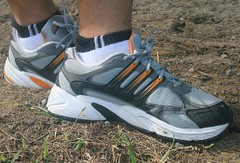 Unlike fats, your body simply cannot store amino acids no matter how much protein you are taking in in your diet. Your body can only take so much whilst the excess amino acids are DEAMINATED.
Unlike fats, your body simply cannot store amino acids no matter how much protein you are taking in in your diet. Your body can only take so much whilst the excess amino acids are DEAMINATED.The figure above shows the chemical formula of AMINO ACID. From the figure you can see that it consists of the amino group and the carboxylic acid group. During the process of DEAMINATION in the LIVER, an amino acid is broken down into two parts - the amino group and the part of the amino acid which contains the carboxylic acid group (which is now referred to as the carbohydrate group).
The carbohydrate group will eventually be converted into GLYCOGEN and stored in the liver itself as well as in your muscle tissues. This GLYCOGEN can be converted to glucose should your body need it as a fuel for cellular respiration. Otherwise, if the glycogen is not utilized within a duration of about 6 hours, it will eventually be converted into FATS and stored in the liver itself as well as in the adipose tissues under your skin.
The amino group on the other hand will be converted to UREA and this UREA will be send (via your blood circulatory system) to your kidneys. Your kidneys will then EXCRETE the UREA along with excess water and minerals (UREA + water + minerals = URINE).
NOTE:
SECRETION vs EXCRETION?
WHEN TO USE THESE TERMS?
SECRETION FOR USEFUL SUBSTANCES LIKE ENZYMES AND HORMONES
WHILST
EXCRETION FOR WASTE PRODUCTS OF METABOLISM LIKE UREA AND CARBON DIOXIDE....
SECRETION vs EXCRETION?
WHEN TO USE THESE TERMS?
SECRETION FOR USEFUL SUBSTANCES LIKE ENZYMES AND HORMONES
WHILST
EXCRETION FOR WASTE PRODUCTS OF METABOLISM LIKE UREA AND CARBON DIOXIDE....
